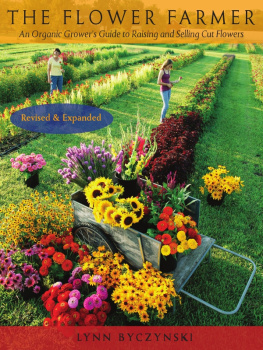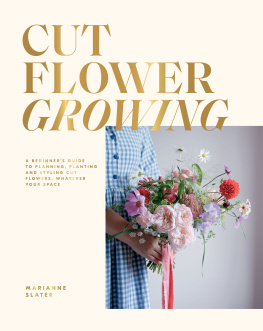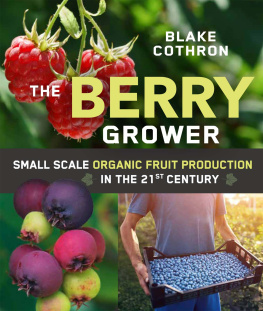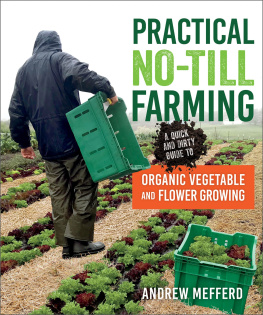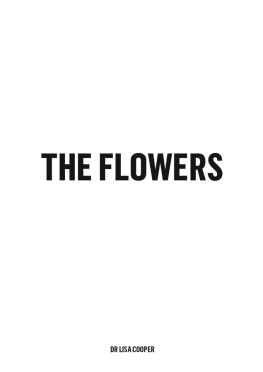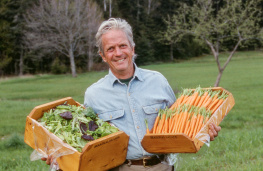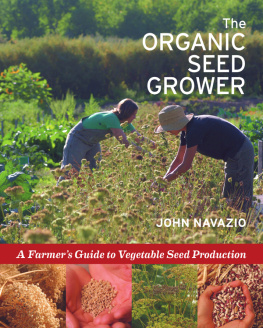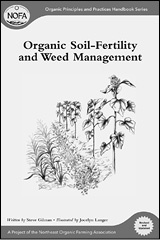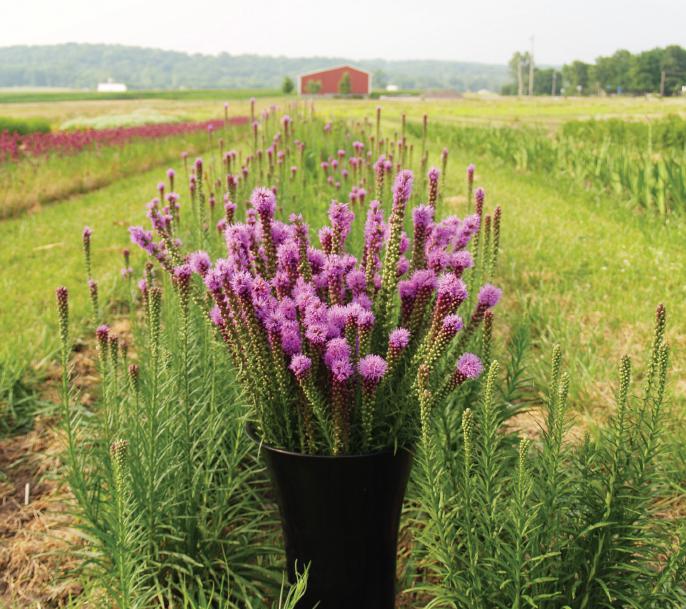
The Flower Farmer
An Organic Growers Guide
to Raising and Selling Cut Flowers
REVISED & EXPANDED
LYNN BYCZYNSKI
CHELSEA GREEN PUBLISHING
WHITE RIVER JUNCTION, VERMONT
Copyright 1997, 2008 by Lynn Byczynski.
Unless otherwise noted, photographs are copyright 2008 by Lynn Byczynski.
Illustrations copyright 1997, 2008 by Robin Wimbiscus.
All rights reserved. No part of this book may be transmitted or reproduced in any form by any means without permission in writing from the publisher.
Developmental Editor: Ben Watson
Project Manager: Emily Foote
Copy Editor: Fern Bradley
Proofreader: Nancy Ringer
Indexer: Christy Stroud
Designer: Peter Holm, Sterling Hill Productions
Printed in the United States of America
12 11 10 09 08
1 2 3 4 5 6 7
Printed on recycled paper
Library of Congress Cataloging-in-Publication Data
Byczynski, Lynn, 1954
The flower farmer : an organic growers guide to raising and selling cut flowers / Lynn Byczynski ; illustrations by Robin Wimbiscus. -- Rev. and expanded ed.
p. cm.
eBook ISBN 978-1-6035-8076-2
1. Floriculture. 2. Organic farming. 3. Cut flower industry. I. Title. II. Title: Organic growers guide to raising and selling cut flowers.
SB406.53.B93 2008
635.9--dc22
2007048446
Our Commitment to Green Publishing
Chelsea Green sees publishing as a tool for cultural change and ecological stewardship. We strive to align our book manufacturing practices with our editorial mission and to reduce the impact of our business enterprise on the environment. We print our books and catalogs on chlorine-free recycled paper, using soy-based inks whenever possible. This book may cost slightly more because we use recycled paper, and we hope youll agree that its worth it. Chelsea Green is a member of the Green Press Initiative (www.greenpressinitiative.org,) a nonprofit coalition of publishers, manufacturers, and authors working to protect the worlds endangered forests and conserve natural resources. The Flower Farmer Revised and Expanded Edition was printed on 68# Renew Matte, a 20-percent postconsumer-waste old-growth-forest-free recycled paper supplied by RR Donnelley.
Chelsea Green Publishing Company
Post Office Box 428
White River Junction, VT 05001
(802) 295-6300
www.chelseagreen.com
FOR DAN
as always
Contents
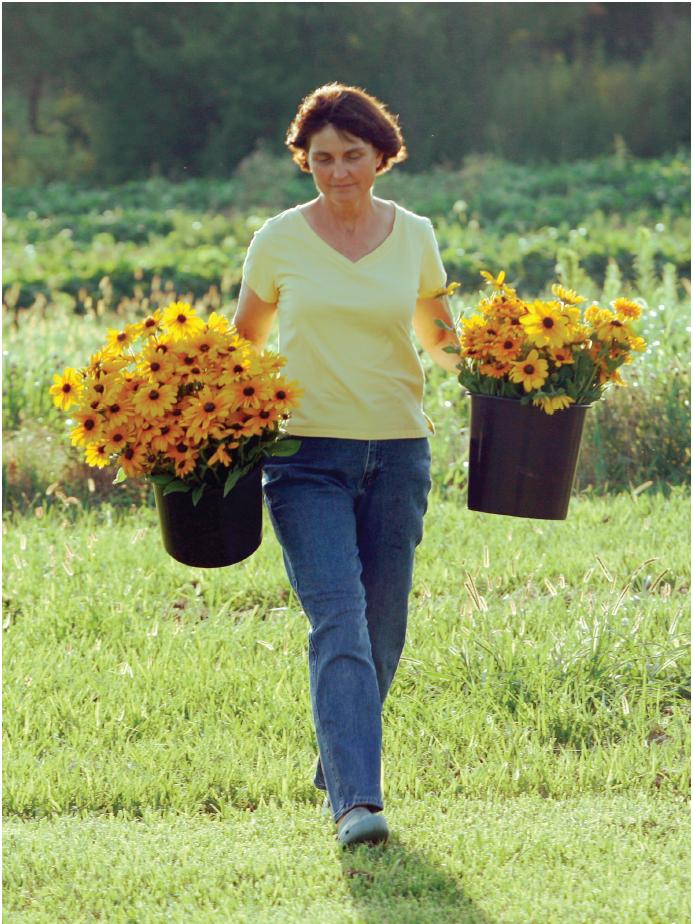
Photo by Wally Emerson
This book was made possible by many people who have supported and inspired me as Ive made my wayfirst, growing flowers, and later, writing about them. I have visited and interviewed countless people who generously shared their ideas and knowledge. To name them all would be impossible, but I hope that those who have answered my questions and opened their gardens to me will recognize themselves and accept my thanks.
I owe much to David Porterfield and Mark Lamantia, the owners of Porterfields Flowers in Topeka, Kansas. Their willingness to buy my flowers has contributed to my familys determination to remain in farming. And I believe that their contributions to this book will help other small farmers establish relationships with florists.
Kudos to Chelsea Green Publishing Company, which is committed to publishing books that help all of us live more meaningful and sustainable lives. Its editors look for books with lasting valueand then keep them in print so that they have a chance to prove their worth. This book is a good example.
To paraphrase Thomas Alva Edison, success is 1 percent inspiration and 99 percent perspiration. It is my hope that aspiring flower growers who read this how-to book will find their inspiration in the profiles of successful farmers. The people who agreed to be featured in this book are true philanthropists. None of them stands to benefit directly from participating in this project, but all have been generous with their time and knowledge. They welcomed me warmly to their farms and held back nothing when I asked questions. Their openness reflects a genuine commitment to the ideal of small-scale farming. Similarly, several growers contributed their Top Ten lists so that others in their regions could be successful with their first flower gardens. Thanks to all of these generous contributors.
Finally, I want to recognize the contributions of my children, Will and Laurel. They have been involved in the flower business since they were babies. During the first summer I sold to florists, Will was only a year old, and he accompanied me into the shops in a pack strapped on my back. Now hes making the deliveries to earn money for college. Laurel, who planted her own little flower gardens when she was a preschooler, is my bouquet maker. Having these wonderful children always nearby has made my choice of occupation all the more fulfilling.
Differences between 1990 USDA hardiness zones and
2006 National Arbor Day Foundation hardiness
zones reflect warmer climate.

Maps used courtesy of the National Arbor Day Foundation, WWW.ARBORDAY.ORG
One of the greatest pleasures of the farming life is the fact that there is always something new to learn. Nature is never static, so those of us who interact with her in the flower garden have to constantly change and adapt. Nor have all her secrets been revealed. The more we learn about the ecological web of the garden and farm, the more we recognize our own ignorance. Gardening, even for its most experienced practitioners, is a lifelong quest for knowledge. I have learned an immense amount about flowers since The Flower Farmer was first published in 1997. I have grown personally in my experience and knowledge, and the world of flowers has changed significantly, too. This new edition of The Flower Farmer is revised, expanded, and updated throughout to bring you the best and most current information about growing flowers for pleasure or income.
One of the most significant issues to emerge since the first edition of this book was published is the changing climate. After years of hedging and denying, scientists, business leaders, and legislators have finally accepted what we farmers have known for a long time: Earths climate is warming. Flower growers see the evidence of global warming in the early arrival of spring, long stretches of hot summer weather, and milder winters. Flowers that used to be guaranteed successes no longer are, while others that never succeeded before are now reliable performers. My own list of most profitable flowers has changed in the past decade, and that has been the case for many growers in other regions as well.
The most graphic illustration of the changing climate and its effects on horticulture is the National Arbor Day Foundations hardiness zone map, which was revised in 2006. Hardiness zones are based on average annual low temperatures, divided by ten-degree increments. The average low temperature in Zone 10 is 30 to 40F (1 to 4C) and the average annual low temperature in Zone 3 is 40 to 30F (40 to 34C). Compared to the 1990 USDA hardiness zone map, Zone 3 has shrunk to a small portion of the northernmost tier of states. Large portions of the United States have warmed at least one full hardiness zone. A few places have warmed two full zones.
Another big change since the first publication of
Next page
